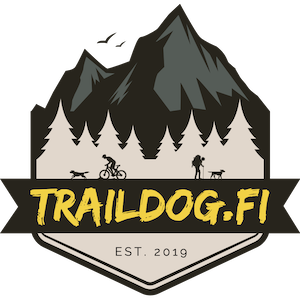Dog hiking gear
What does a dog need for hiking?
The packing list for hiking is always a compromise: either you take only the essentials for survival or you go for comfort without fearing extra weight. Either way, taking a dog on a hike naturally increases the amount of gear needed. The person hiking with a dog is responsible not only for themselves but also for the dog's well-being, so it is good to consider possible problem situations and how to handle them in advance. Below you will find a packing list that you can use as a basis for preparing for your own trips.

Traildog's packing list for hiking with a dog
- Dog sleeping pad. The ground radiates cold and moisture, so a sleeping pad is essential even for thick-coated dogs. The sleeping pad also protects the tent floor from claws if the dog sleeps inside the tent. You can get an affordable and lightweight sleeping pad made of foam, but the dogs that want comfort and are sensitive to cold may need a more padded pad and/or an additional cushion/warming layer on top of the pad.
- Jacket and/or sleeping bag for the night. It is also good for long-haired dogs to get warmth especially at night for muscles tired from hiking. Very thick-coated dogs used to sleeping outdoors may not need this. The thinnest-coated indoor dogs often need both a jacket and an additional warmer like a sleeping bag, at least if the night temperature is only a few degrees or colder.
- Rain jacket and/or a lightweight, absorbent towel. A wet dog must be dried before crawling into the tent. A damp coat easily cools the dog's muscles.
- Harnesses. On hikes, there may be tight spots where the dog may need assistance. It is much safer to lift and assist a dog by the harness than by the collar.
- Bowl. A foldable food/water bowl saves space. The smallest foldable bowls easily fit, for example, in the small pocket of a backpack's hip belt.
- Booties. Even if the hiking terrain is easy, a paw pad or nail injury can happen anywhere. Get, for example, lightweight rubber-coated booties for the first aid kit that protect the paw pads from strain and also keep any paw bandage dry.
- First aid supplies (e.g., bandages, disinfectant, space blanket, allergy medicine for insect stings, paw wax (also preventive). You can assemble first aid supplies yourself or get a ready comprehensive first aid kit.
- Energy-rich food. On hikes, the dog's energy consumption is high. The food should therefore be as energy-dense as possible. The most important thing is that the dog's stomach has been accustomed in advance to the food offered on the trip. Diarrhea and hiking are a bad combination! Dog food is usually the heaviest extra weight for someone hiking with a dog, but fortunately it diminishes over the hiking days. If you want to move with as light gear as possible, consider dried meat for the dog that you soak in water. There are also freeze-dried hiking foods available for dogs, whose packaging volume is smaller than dry kibble.
- Water. Plan in advance how much water your dog needs and where you can refill water supplies.
- Waterproof packing bags: If your dog has its own backpack, it is good to pack moisture-sensitive gear/food inside waterproof packing bags/minigrips. Be prepared for heavy rain, and most dog backpacks are not completely waterproof.
- Possibly a backpack for the dog. Getting used to the backpack must always start well before the actual hike. Learn more about this topic and choosing a backpack here: Dog backpack selection guide
- Canicross belt for the human. Many want to keep their hands free while hiking, so attaching the leash to the waist is a convenient option. However, it is worth remembering that backpack hip belts and their buckles are usually not designed to withstand forward pulling force. If you do not want to risk breaking the backpack, a separate canicross belt is a good option. Check out our canicross belt selection guide.
Other useful items:
- A piece of duct tape. For emergencies and repairing broken gear.
- Climbing carabiner or carabiner. A lightweight item that often finds use. With an extra carabiner, you can easily clip the dog's leash around a tree or attach gear to the outside of the backpack.


